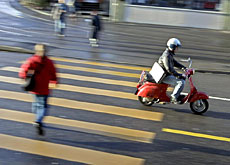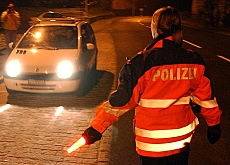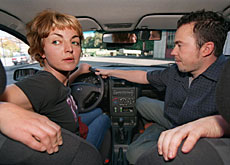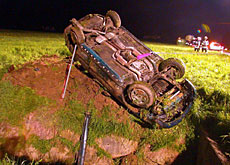New measures give clear sign to drivers

More than 900 pedestrians are injured every year on Swiss zebra crossings, but new regulations are set to make walking across the road a lot safer.
From Wednesday police can issue on-the-spot fines of SFr140 ($106) if a driver does not give a pedestrian right of way at a zebra crossing.
“I’m very glad we’ve come so far because this is a proposal that I made in the House of Representatives some five years ago,” said former parliamentarian Roland Wiederkehr, president of the Road Cross, an association for road accident prevention.
Police will now be able to hand out these fines even if the pedestrian was not endangered in any way. Until now the police have had to file a report which would result in a court summons.
Even then Wiederkehr explained it was often a lot of work for nothing. “When we conducted an investigation in canton St Gallen, of 28 drivers who did not give way to pedestrians only six could be brought before the judge – 22 had to be let go,” he told swissinfo.
Wiederkehr said the reason why the situation is not like it is in Germany – “where it’s clear that drivers always stop if pedestrians are around” – is tradition.
“Until recently every pedestrian in Switzerland had to give a hand signal [to drivers] when he wanted to cross the street. But this was often misused by lawyers – their clients had had an accident and they then pretended that the pedestrian hadn’t given this sign.”
Police action
In addition to the fines, vehicles with top speeds less than 80km/h will be banned from the motorways (previously it was 60km/h) and the wearing of seatbelts is now mandatory for taxi drivers and in all other vehicles that have belts. Older vehicles have until 2010 to get fitted out with seatbelts.
Police will also introduce the use of cameras in unmarked police cars to monitor pedestrian crossings.
Several cantons in German-speaking Switzerland are planning to coordinate their monitoring measures in the autumn.
Werner Friedli, from Brugg police, said that taking action at the scene was very important as that was the only way drivers could be made aware of the new rules.
Drivers’ error
Although the number of traffic fatalities and injuries in general dropped significantly last year, the number of accidents at pedestrian crossings – especially those concerning children – were still going in the wrong direction.
According to Road Cross, the number of children injured on crossings rose by 13 per cent last year, and those seriously injured by 69 per cent.
Many drivers claim it’s not their fault, citing a lack of road markings and signs. Indeed, an investigation by cantonal police in the Swiss capital, Bern, found that 14 per cent of the 823 crossings they looked at could be improved.
But Wiederkehr is adamant where the blame lies. “It cannot be said that pedestrians are too careless and don’t look left and right because over 60 per cent of accidents in Switzerland happen on the second part of the pedestrian crossings,” he said.
“The drivers coming from the right are not careful enough.”
Youth court
One example of a pedestrian being hit from the right – and which provoked a change in the law – was that of Susanne Koch (see attached video).
Two years ago Koch, then aged seven, crossed a badly marked zebra crossing and was hit – and hospitalised – by a driver who said she just ran out from behind a bus.
Nothing happened to the driver, but the authorities charged the girl with crossing the road without due care.
Last month she was acquitted by the youth court. But the outcry surrounding the case was such that from now on children under 12 will be questioned after an accident before being sent a summons.
swissinfo, Thomas Stephens
Traditionally in Switzerland pedestrians at zebra crossings had to give drivers some sort of hand signal if they wanted to cross to the other side.
A regulation was introduced in 1994 saying pedestrians – whether signalling or not – had absolute right of way at zebra crossings.
This led to confusion among drivers and the number of injuries to pedestrians increased.
From March 1:
Police may issue on-the-spot fines if a driver does not give right of way to a pedestrian at a zebra crossing.
Vehicles with top speeds under 80km/h will be banned from the motorways.
Taxi drivers must wear seatbelts as must other drivers if they have them.
Helmets are obligatory when riding quad bikes and bikes with three wheels.

In compliance with the JTI standards
More: SWI swissinfo.ch certified by the Journalism Trust Initiative




You can find an overview of ongoing debates with our journalists here . Please join us!
If you want to start a conversation about a topic raised in this article or want to report factual errors, email us at english@swissinfo.ch.